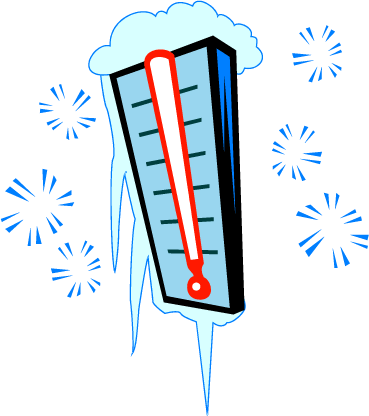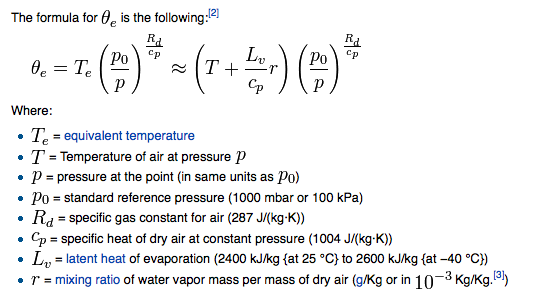“Cold” equivalent potential temperature?
 As scientists, we need to be precise in our writing. Evgeni Fedorovich at the University of Oklahoma has tried to keep me honest about writing about “cold temperatures”. Know that the air can be “cold” or “warm”, but temperatures are “high” or “low.”
As scientists, we need to be precise in our writing. Evgeni Fedorovich at the University of Oklahoma has tried to keep me honest about writing about “cold temperatures”. Know that the air can be “cold” or “warm”, but temperatures are “high” or “low.”
I want to take this argument one step further. It makes no sense to talk about “cold equivalent potential temperature” either.
This is particularly true because equivalent potential temperature (theta-e) is a combination of moisture content and temperature. So, two parcels of air with the same air temperature could have different equivalent potential temperatures if they differed in their mixing ratios.
Equation for theta-e from Wikipedia.
(Thermometer image from http://liberalbureaucracy.blogspot.co.uk)



First, I completely agree with Evgeni. A substance can be hot or cold, but a measurement cannot. In the same vein, I would agree that equivalent potential temperature also should not be hot or cold.
When writing or editing manuscripts that pertain to hot or cold air, I also try to flag statements that include “hot air” or “cold air.” If what constitutes “hot” and/or “cold” is not defined in the context of the work in question, “hot” or “cold” is subjective. Comparatives (hotter and colder) are fine, of course, but substances are not intrinsically hot or cold (unless the substance has a temperature of 0 Kelvin, I suppose).
Finally, in the interest of precise writing: I don’t quite agree that one should not talk about hot and cold theta-e because parcels of air with the same air temperature might have different mixing ratios. I see theta-e as a means of accounting for the influence of water vapor on density/stability by interpreting that influence as a temperature perturbation. In that context, I don’t believe hot and cold theta-e is any more or less appropriate than hot and cold temperature. I feel it is most accurate to state that one should not use hot and cold because theta-e is not a substance, not because it combines temperature and mixing ratio.
I disagree with Jay regarding the “appropriateness” of “hot or cold” applied to theta-e. Since this variable is a function of two variables, it would be just as (in)appropriate to refer to values of theta-e as “wet or dry”. The distinction between hot and cold is clearly associated with temperature, so using it to describe theta-e would inappropriately ignore the contribution of water vapor content to theta-e. Proper use would be “high or low” values.
I DO agree that the primary argument against referring to temperatures as “hot and cold” is inappropriate because the temperature is a measurement, not an object. And the same argument would apply to either “hot or cold” or “wet or dry” when applied to theta-e.
edit: “I DO agree that the primary argument against referring to temperatures as “hot and cold” is because the temperature …”
Since theta-e has units of temperature and is used in most (perhaps all?) applications as a temperature, I think the difference in appropriateness between hot and cold temperature and hot and cold theta-e is pretty fine. I agree there is a real physical difference between temperature and theta-e, but once that physical difference is accounted for as a perturbation with units of temperature, referring to “hot or cold” theta-e does not in fact ignore the contribution of water vapor (except semantically). So in that context, which I defined above, I feel my statement is accurate.
We agree that it’s inappropriate in both cases, but I guess we disagree on whether one is more inappropriate than the other.
In perhaps a somewhat similar vein, I suggest people eschew the transposing of reflectivity units (dBZ) with the reflectivity value. For example, I have seen people write along the lines of “the storm had a maximum dBZ of 50.” That is akin to writing “our trip had a maximum miles of 200.” Each case can be rectified by writing “the storm had a maximum reflectivity of 50 dBZ” and “our trip was a distance of 200 miles,” respectively.
This is an excellent point, Matt. Thank you.